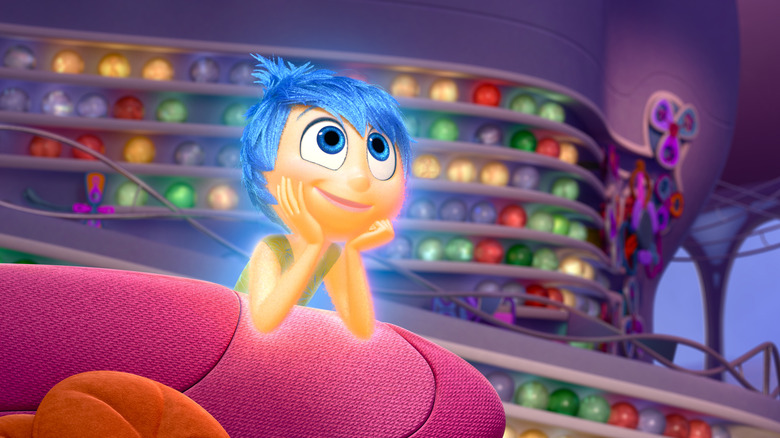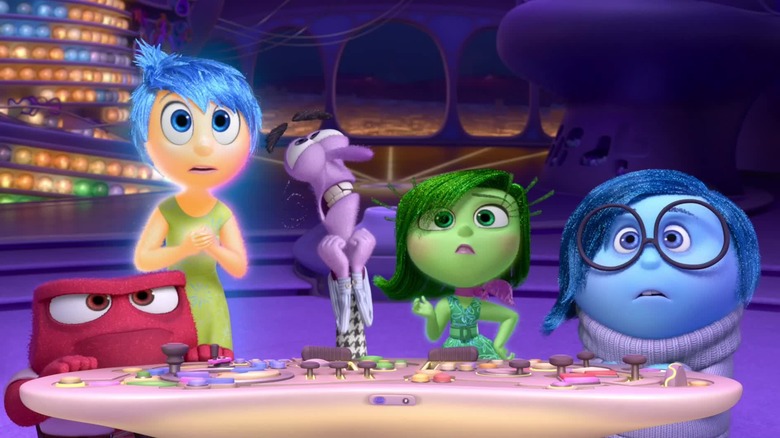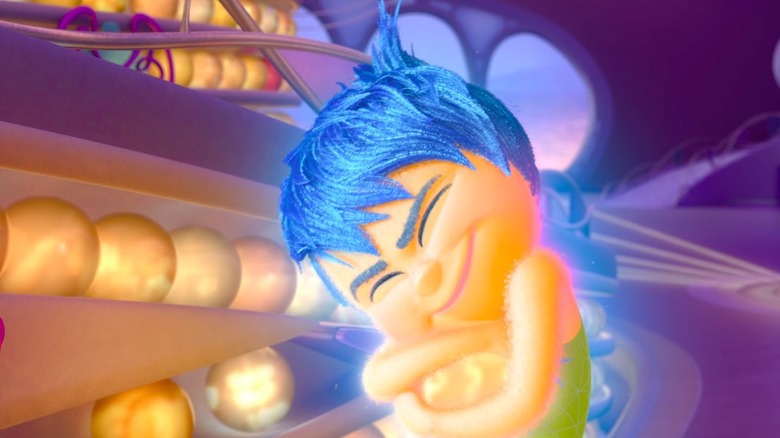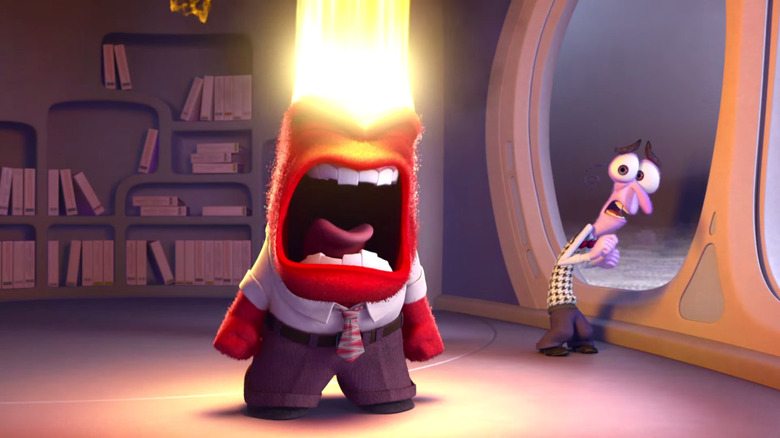The Idea For Inside Out Came From The Production Of Pixar's Up
Peter Docter's 2015 film "Inside Out" is possibly the best film put out by Pixar. Set partly inside the brain space of an 11-year-old girl named Riley, the film is about five anthropomorphic emotions — Joy, Sadness, Disgust, Fear, and Anger — who serve as the "pilots" of their human host. Each one gets to feed emotions to Riley, but Joy (voiced by Amy Poehler) is still the one largely in control. Sadness (Phyllis Smith), however, seems to be unwittingly wresting control when Riley moves away from her beloved childhood home and sets up in a dinky apartment in San Francisco. In a bold statement for a children's film, "Inside Out" declares that Joy cannot possibly be a permanent state, and a vital part of growing up will be to form core memories based on bittersweet moments. Life, it says, is not going to be happy all the time, and that's part of being alive. And all this is before the anthropomorphic emotions have a chance to push the "puberty" button.
Docter, currently serving as the Pixar's chief creative head, started directing at the company in 2001 with "Monsters, Inc.," and he went on to direct the well-received 2009 weepy "Up." It was during the production of "Up" — a strange movie about a balloon-lifted house, a rogue zeppelin, and talking dog pilots — that Docter found himself pondering what sort of daring-but-relatable story he could do next, and his relationship with his own 11-year-old daughter inspired him to make "Inside Out."
In a 2015 interview with Movieguide, Docter talked about the job distribution at Pixar, and the above process, leading to the invention of anthropomorphic emotions.
Can you guys do another one?
Pete Docter, having such a long career at Pixar, spelled out how certain directors, producers, and executives work together, and how carefully Pixar employees have to balance the novel with the recognizable. Docter wanted at first — in an abstract way — to something completely original:
"Somehow after 'Toy Story,' John [Lasseter] let me develop a movie which became 'Monsters, Inc.' Which, actually, Joe Grant came up with the title for that. I don't really remember asking, but somehow I ended up directing that. That was my first gig as a director. [Producer] Jonas [Rivera] worked in the art department on that so then after that he and I worked on 'Up,' which came out in 2009. They were nice enough to say, 'Hey can you guys do another one?' The thought was, you always want to do something new, you always want to bring people somewhere that they haven't been before, do something that they haven't seen."
But he didn't want it to be so original that no one could recognize it. A seeming mandate at Pixar seems to be emotional realism, mostly telling stories that, however fantastical, have a palpable core of recognizable human feelings:
"Yet, I also knew I have done the more extreme version of that, that if you go too far, if you pitch something that has no bearing on reality and nothing for people to grab onto, then they don't engage."
Docter doesn't mention what kind of "more extreme" projects he was referring to (his student films "Palm Springs," "Next Door," and "Winter" are all pretty gentle and comprehensible), though a book of rejected Pixar ideas would most certainly be a fascinating read. What could be too extreme after high-concept movies like "Up" and "Inside Out?"
Ellie in Up
In 2009, Pete Docter's own 9-year-old daughter Elie played the voice of the young Ellie in the opening scenes of "Up," and Docter recalls his daughter being joyful and sociable at the time. He also recalls the shift she went through in the next few years, becoming something more like a typical sullen preteen. This played into Docter's need to bring something original to the screen:
"My thought was I wanted to bring the audience something that they could relate to, yet no one had ever seen before. That seemed kind of impossible. Then, I had this idea, and it really started with my daughter. She was about 9 when she did the voice of young Ellie in 'Up.' She was really a lot like that character. She was full of a lot of energy, running around talking to people. Then, she turned 11, and suddenly we saw a lot more moments of moping and quiet. It made me wonder, what happened to that childhood joy? What was going on inside her head?"
Using that as a starting point, Docter began to imagine how that sullenness and quiet takes over in cartoon terms: Emotional avatars live inside your head, alternately taking over control of your brain. That expanded into a more literal universe where basic cerebral functions all exist in 3D space. Memories are now glowing orbs stored on racks. Dreams and nightmares are on-the-fly film editing exercises. Notably, there are no figures of logic or intellect representing the left brain. Human beings are ruled by one of five emotional states.
Herman's Head
The personification of emotional states wasn't a wholly original concept, and media-savvy TV viewers were quick to point to the 1991 Fox sitcom "Herman's Head" as suspicious precedent. "Herman's Head" was about an average yuppie named Herman (William Ragsdale from "Fright Night") whose life is constantly being narrated by a chorus of emotional beings living in his head and envisioned as existing in an attic room together. Sensitivity, Lust, Anxiety, and Logic fought for dominance in Herman's mind, with occasional appearances by Jealousy and, in a theological twist, God.
Many critics made the comparison to the Fox sitcom, though Pete Docter himself told Metro US in 2015:
"You know what, it took like three years into the project before somebody said, 'Have you heard of "Herman's Head"?' And I was like, 'No, what is that?' I'm aware of it, but I certainly wasn't when I started on this. There was a part of one on YouTube, and that's the only bits I've seen. It seemed similar in concept, I guess, in some ways, but quite different, too."
It seems Docter was far more interested in exploring his own child's psyche than making cutesy, kitschy references to long-forgotten '90s TV shows. Additionally, "Inside Out" served as a criticism of most children's entertainment that is so often insistent on a constantly joyous mindset. That is: Keep the kids giggling and excited, ignore the "serious" emotions of anger and sadness, and that will make it more "kid-appropriate." "Inside Out" was a rebuke to the concept, and Docter seems to have done that consciously.
At any rate, the movie is better than the TV show.



